| Sketchley's Statistics | MRG - play stats here ABOUT LINKS |  MAIN INDEX
MAIN INDEX |
||
|---|---|---|---|---|
| LOCATIONS | TRANSLATIONS | FAQ & RULES | UPDATES | |
| By AARON SKETCHLEY (aaronsketch@HOTdelete_thisMAIL.com) | 2024.01.08 Ver 3.7 |
| Sketchley's Statistics | MRG - play stats here ABOUT LINKS |  MAIN INDEX
MAIN INDEX |
||
|---|---|---|---|---|
| LOCATIONS | TRANSLATIONS | FAQ & RULES | UPDATES | |
| By AARON SKETCHLEY (aaronsketch@HOTdelete_thisMAIL.com) | 2024.01.08 Ver 3.7 |
| The Solar System - Trans-Neptunian & Farthest Regions |
|---|
| Kuiper Belt |
|---|
 The Kuiper belt is a region of the Solar System beyond the planets, extending from the orbit of Neptune (at 30 AU) to approximately 50 AU from the Sun. It is similar to the asteroid belt, but it is far larger- 20 times as wide and 20 to 200 times as massive. Like the asteroid belt, it consists mainly of small bodies, or remnants from the Solar System's formation. Although many asteroids are composed primarily of rock and metal, most Kuiper belt objects are composed largely of frozen volatiles (termed "ices"), such as methane, ammonia and water. The Kuiper belt is home to three officially recognized dwarf planets: Pluto, Haumea, and Makemake. Some of the Solar System's moons, such as Neptune's Triton and Saturn's Phoebe, are also believed to have originated in the region.
The Kuiper belt is a region of the Solar System beyond the planets, extending from the orbit of Neptune (at 30 AU) to approximately 50 AU from the Sun. It is similar to the asteroid belt, but it is far larger- 20 times as wide and 20 to 200 times as massive. Like the asteroid belt, it consists mainly of small bodies, or remnants from the Solar System's formation. Although many asteroids are composed primarily of rock and metal, most Kuiper belt objects are composed largely of frozen volatiles (termed "ices"), such as methane, ammonia and water. The Kuiper belt is home to three officially recognized dwarf planets: Pluto, Haumea, and Makemake. Some of the Solar System's moons, such as Neptune's Triton and Saturn's Phoebe, are also believed to have originated in the region.
The main body of the belt is generally accepted to extend from the 2:3 resonance [with Neptune] at 39.5 AU to the 1:2 resonance at roughly 48 AU. The Kuiper belt is quite thick, with the main concentration extending as much as ten degrees outside the ecliptic plane and a more diffuse distribution of objects extending several times farther. Overall it more resembles a torus or doughnut than a belt.
 The presence of Neptune has a profound effect on the Kuiper belt's structure due to orbital resonances. Over a timescale comparable to the age of the Solar System, Neptune's gravity destabilises the orbits of any objects that happen to lie in certain regions, and either sends them into the inner Solar System or out into the scattered disc or interstellar space. This causes the Kuiper belt to possess pronounced gaps in its current layout, similar to the Kirkwood gaps in the asteroid belt.
The presence of Neptune has a profound effect on the Kuiper belt's structure due to orbital resonances. Over a timescale comparable to the age of the Solar System, Neptune's gravity destabilises the orbits of any objects that happen to lie in certain regions, and either sends them into the inner Solar System or out into the scattered disc or interstellar space. This causes the Kuiper belt to possess pronounced gaps in its current layout, similar to the Kirkwood gaps in the asteroid belt.

| Orcus |
|---|
 A likely dwarf planet. Orcus is a plutino, locked in a 2:3 resonance with Neptune, making two revolutions around the Sun to every three of Neptune's. This is much like Pluto, except that it is constrained to always be in the opposite phase of its orbit from Pluto. Moreover, the aphelion of Orcus's orbit points in nearly the opposite direction from Pluto's, although the eccentricities and inclinations are similar. Because of these similarities and contrasts, along with its large moon Vanth that recalls Pluto's large moon Charon, Orcus has been regarded as the anti-Pluto.
A likely dwarf planet. Orcus is a plutino, locked in a 2:3 resonance with Neptune, making two revolutions around the Sun to every three of Neptune's. This is much like Pluto, except that it is constrained to always be in the opposite phase of its orbit from Pluto. Moreover, the aphelion of Orcus's orbit points in nearly the opposite direction from Pluto's, although the eccentricities and inclinations are similar. Because of these similarities and contrasts, along with its large moon Vanth that recalls Pluto's large moon Charon, Orcus has been regarded as the anti-Pluto.
The surface of Orcus is grey in color and water-rich. The ice is predominantly in crystalline form, which may be related to past cryovolcanic activity. Models of internal heating via radioactive decay suggest that Orcus may be capable of sustaining an internal ocean of liquid water.
1994 JR1 is moving in a very stable orbit, likely as stable as Pluto's. This suggests that it may be a primordial plutino formed around the same time Pluto itself and Charon came into existence. It is unlikely to be relatively recent debris originated in collisions within Pluto's system or a captured object.

| 2003 VS2 |
|---|
| Pluto |
|---|
 It is the largest and second-most-massive known dwarf planet in the Solar System, and the ninth-largest and tenth-most-massive known object directly orbiting the Sun. It is the largest known trans-Neptunian object by volume but is less massive than Eris, a dwarf planet in the scattered disc. Like other Kuiper belt objects, Pluto is primarily made of ice and rock and is relatively small - about one-sixth the mass of the Moon and one-third its volume. It has a moderately eccentric and inclined orbit during which it ranges from 30 to 49 AU. This means that Pluto periodically comes closer to the Sun than Neptune, but a stable orbital resonance with Neptune prevents them from colliding. Light from the Sun takes about 5.5 hours to reach Pluto at its average distance (39.4 AU). The amount of light from the Sun on Pluto is weak, analogous to twilight on Earth.
It is the largest and second-most-massive known dwarf planet in the Solar System, and the ninth-largest and tenth-most-massive known object directly orbiting the Sun. It is the largest known trans-Neptunian object by volume but is less massive than Eris, a dwarf planet in the scattered disc. Like other Kuiper belt objects, Pluto is primarily made of ice and rock and is relatively small - about one-sixth the mass of the Moon and one-third its volume. It has a moderately eccentric and inclined orbit during which it ranges from 30 to 49 AU. This means that Pluto periodically comes closer to the Sun than Neptune, but a stable orbital resonance with Neptune prevents them from colliding. Light from the Sun takes about 5.5 hours to reach Pluto at its average distance (39.4 AU). The amount of light from the Sun on Pluto is weak, analogous to twilight on Earth.
Pluto and Charon are sometimes considered a binary system because the barycenter of their orbits does not lie within either body. The IAU has not formalized a definition for binary dwarf planets, and Charon is officially classified as a moon of Pluto.
Pluto's rotation period, its day, is equal to 6.39 Earth days. Like Uranus, Pluto rotates on its "side" on its orbital plane, with an axial tilt of 120°, and so its seasonal variation is extreme - at its solstices, one-fourth of its surface is in continuous daylight, whereas another fourth is in continuous darkness.
Pluto's surface is composed of more than 98% nitrogen ice, with traces of methane and carbon monoxide. The face of Pluto oriented toward Charon contains more methane ice, whereas the opposite face contains more nitrogen and carbon monoxide ice. Pluto's surface is quite varied, with large differences in both brightness and color. Pluto is one of the most contrastive bodies in the Solar System, with as much contrast as Saturn's moon Iapetus. The color varies between charcoal black, dark orange and white. Pluto's color is more similar to that of Io, with slightly more orange, and significantly less red than Mars. Notable geographical features include Tombaugh Regio, or the "Heart" (a large bright area on the side opposite Charon), Cthulhu Regio, or the "Whale" (a large dark area on the trailing hemisphere), and the "Brass Knuckles" (a series of equatorial dark areas on the leading hemisphere).
Pluto has a thin atmosphere consisting of nitrogen, methane, and carbon monoxide, which are in equilibrium with their ices on Pluto's surface. The surface pressure is roughly one million to 100,000 times less than Earth's atmospheric pressure. Pluto's elliptical orbit is predicted to have a major effect on its atmosphere: as Pluto moves away from the Sun, its atmosphere should gradually freeze out. When Pluto is closer to the Sun, the temperature of Pluto's solid surface increases, causing the ices to sublimate. Just like sweat cools the body as it evaporates from the skin, this sublimation cools the surface of Pluto.[123]
 Charon
Charon
Charon's diameter is larger than the dwarf planet Ceres. Charon is sufficiently massive to have collapsed into a spheroid under its own gravity. Unlike Pluto's surface, which is composed of nitrogen and methane ices, Charon's surface appears to be dominated by the less volatile water ice. Charon is slightly less dense than Pluto and thus contains a larger proportion of ice relative to rock in its interior; the difference is considerably lower than that of most suspected collisional satellites.
Photometric mapping of Charon's surface shows a latitudinal trend in albedo, with a bright equator band and darker poles. The south polar region is apparently darker than the north. The north polar region is dominated by a very large dark area informally dubbed "Mordor" by the New Horizons team. Aside from Mordor, however, New Horizons imaged very few other impact craters on Charon and found a youthful surface, adding support to the above theory that Charon is geologically active and thus probably differentiated.
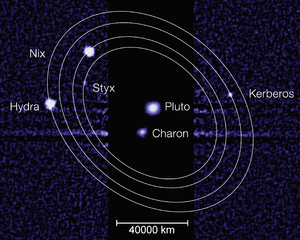
 Nix
Nix
Its orbital period of 24.9 days is also close to a 1:4 orbital resonance with Charon, but the timing discrepancy is 2.8%; there is no active resonance. A hypothesis explaining such a near-resonance is that it originated before the outward migration of Charon following the formation of all five known moons, and is maintained by the periodic local fluctuation of 9% in the Pluto-Charon gravitational field strength.
As with Hydra and perhaps the other small Plutonian moons, Nix rotates chaotically; the moon's axial tilt and day length vary greatly over short timescales, to the point that it regularly flips over. Early research appeared to show that Nix was reddish like Pluto and unlike the other moons, but more-recent reports have been that it is grey like the remaining satellites. New Horizons spotted a large region with a distinctive red tint, probably a crater, which may explain these conflicting results.
Like Pluto's other satellites, it is suspected that Kerberos coalesced from the debris of a massive collision between Pluto and another Kuiper belt object, similar to the giant impact thought to have created the Moon. However, Kerberos's low albedo is a challenge to explain with such a model; if formed in a collision, Kerberos would normally be expected to have a brighter albedo similar to that of Charon, Nix, Hydra, and perhaps Styx (whose albedo is yet undetermined).
 Hydra
Hydra
Hydra is in a 2:3 orbital resonance with Nix, and a 6:11 resonance with Styx. As a result of this "Laplace-like" 3-body resonance, it has conjunctions with Styx and Nix in a 5:3 ratio.
Its orbital period is also close to a 1:6 orbital resonance with Charon, with the timing discrepancy being 0.3%. A hypothesis to explain the near-resonance is that it originated before the outward migration of Charon following the formation of all five known moons, and is maintained by the periodic local fluctuation of 5% in the Pluto-Charon gravitational field strength.
Like Saturn's moon Hyperion, Nix, and likely the other small Plutonian moons, Hydra rotates chaotically; its day length, rotational axis, and even rotational axis vary quickly over astronomical timescales, to the point that it regularly flips over. This is largely due to the aforementioned fluctuation of the Pluto-Charon gravitational field, as well as its irregular shape.
Hydra appears to be spectrally neutral like Charon and Nix, whereas Pluto is reddish.
| Ruins of South Ataria Island |
|---|

 When the SDF-1 undertook the emergency fold at the start of SWI, it took South Ataria Island and a large amount of the surrounding Pacific waters with it, depositing them 'near Pluto.'
When the SDF-1 undertook the emergency fold at the start of SWI, it took South Ataria Island and a large amount of the surrounding Pacific waters with it, depositing them 'near Pluto.'
Presently (as of 2050-2060), it is slowly spreading over a larger area due to events that occured immediately after its arrival and subsequent interactions with gravity fields and the Solar Wind. The area looks more like an icey 'smudge' (perhaps occasionally being mistaken for a comet) in space.
| 2003 AZ84 |
|---|
The spectra and colors of 2003 AZ84 are very similar to those of Orcus. Both bodies have a flat featureless spectrum in the visible and moderately strong water ice absorption bands in the near-infrared, although 2003 AZ84 has a lower albedo.
| Ixion |
|---|
Ixion's surface is a mixture of water ice, dark carbon and tholin, which is a heteropolymer formed by irradiation of clathrates of water and organic compounds. It is possible that Ixion could develop a coma or temporary atmosphere when it is closer to perihelion.
| Huya |
|---|
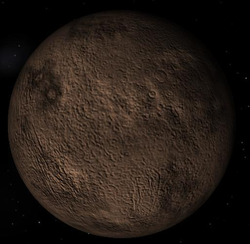 A plutino, in a 2:3 mean-motion resonance with Neptune. It is possibly a dwarf planet. Light-curve-amplitude analysis, which shows only small deviations, suggests that it is likely a spheroid with small albedo spots. Huya has a moderately red-sloped reflectance spectrum in the visible and near-infrared, suggesting a surface rich in organic material such as tholins.
A plutino, in a 2:3 mean-motion resonance with Neptune. It is possibly a dwarf planet. Light-curve-amplitude analysis, which shows only small deviations, suggests that it is likely a spheroid with small albedo spots. Huya has a moderately red-sloped reflectance spectrum in the visible and near-infrared, suggesting a surface rich in organic material such as tholins.
| 2005 RN43 |
|---|
| 2002 MS4 |
|---|
| Salacia |
|---|
| 2004 GV9 |
|---|
| 2002 UX25 |
|---|
 A highly likely dwarf planet. A variability of the visual brightness was detected which could be fit to a period of 14.38 or 16.78 h. It is redder than Varuna, unlike its neutral-colored "twin" 2002 TX300, in spite of similar brightness and orbit elements.
A highly likely dwarf planet. A variability of the visual brightness was detected which could be fit to a period of 14.38 or 16.78 h. It is redder than Varuna, unlike its neutral-colored "twin" 2002 TX300, in spite of similar brightness and orbit elements.
2002 UX25 is one of the largest known solid objects in the Solar System that is less dense than water. Why this should be is not well understood: objects of its size in the Kuiper belt are typically rocky and dense, and to have a similar composition to others of its kind, it would have to be exceptionally porous, which is unlikely given the compactability of water ice.
| Varuna |
|---|
 Probably a dwarf planet. Varuna is classified as a classical TNO and follows a near-circular orbit.
Probably a dwarf planet. Varuna is classified as a classical TNO and follows a near-circular orbit.
Varuna has a rotational period of approximately 6.34 hours. It has a double-peaked light curve. Given the rapid rotation, rare for objects so large, Varuna is thought to be an elongated spheroid (ratio of axis 2:3)
The surface of Varuna is moderately red (similar to Quaoar) and small amounts of water ice have been detected on its surface. The most probable composition for the surface of Varuna is a mixture of amorphous silicates (25%), complex organics (35%), amorphous carbon (15%) and water ice (25%). However, they also discuss another possible surface composition containing up to a 10% of methane ice. For an object with the characteristics of Varuna, this volatile could not be primordial, so an event, such as an energetic impact, would be needed to explain its presence on the surface.
| Haumea |
|---|
 Although its shape has not been directly observed, calculations from its light curve suggest it is an ellipsoid, with its major axis twice as long as its minor. This elongation, along with its unusually rapid rotation, high density, and high albedo (from a surface of crystalline water ice), are thought to be the results of a giant collision, which left Haumea the largest member of a collisional family that includes several large trans-Neptunian objects (TNOs) and its two known moons, Hi'iaka and Namaka. Its extreme elongation makes it unique among known dwarf planets.
Although its shape has not been directly observed, calculations from its light curve suggest it is an ellipsoid, with its major axis twice as long as its minor. This elongation, along with its unusually rapid rotation, high density, and high albedo (from a surface of crystalline water ice), are thought to be the results of a giant collision, which left Haumea the largest member of a collisional family that includes several large trans-Neptunian objects (TNOs) and its two known moons, Hi'iaka and Namaka. Its extreme elongation makes it unique among known dwarf planets.
Haumea's orbit has a slightly greater eccentricity than the other members of its collisional family. This is thought to be due to Haumea's weak 7:12 orbital resonance with Neptune gradually modifying its initial orbit over the course of a billion years, through the Kozai effect, which allows the exchange of an orbit's inclination for increased eccentricity.
Haumea displays large fluctuations in brightness over a period of 3.9 hours, which can only be explained by a rotational period of this length. This is faster than any other known equilibrium body in the Solar System, and indeed faster than any other known body larger than 100 km in diameter. This rapid rotation is thought to have been caused by the impact that created its satellites and collisional family.
Haumea is the largest member of its collisional family, a group of astronomical objects with similar physical and orbital characteristics thought to have formed when a larger progenitor was shattered by an impact. A proposal suggests that the material ejected in the initial collision instead coalesced into a large moon of Haumea, which was later shattered in a second collision, dispersing its shards outwards.
| Quaoar |
|---|
 A probable dwarf planet, with suggestions of an elongated shape. Light-curve-amplitude analysis shows only small deviations, suggesting that Quaoar is indeed a spheroid with small albedo spots.
A probable dwarf planet, with suggestions of an elongated shape. Light-curve-amplitude analysis shows only small deviations, suggesting that Quaoar is indeed a spheroid with small albedo spots.
At 43 AU and a near-circular orbit, Quaoar is not significantly perturbed by Neptune, unlike Pluto, which is in 2:3 orbital resonance with Neptune. Pluto is closer to the Sun than Quaoar at some times of its orbit, and farther at others.
The surface is moderately red. Larger KBOs are often much brighter because they are covered in more fresh ice. A model of internal heating via radioactive decay suggested that, unlike Orcus, Quaoar may not be capable of sustaining an internal ocean of liquid water at the mantle-core boundary.
| 2002 TX300 |
|---|
 A bright Kuiper belt object. A possible dwarf planet. It is a large member of the Haumea family.
A bright Kuiper belt object. A possible dwarf planet. It is a large member of the Haumea family.
A variability of the visual brightness was also detected which could fit to 7.9 h or 15.8 h rotational period. The changes in brightness are quite close to the error margin and could also be due to an irregular shape.
Mineralogical analysis indicates a substantial fraction of large ice (H2O) particles. The signal-to-noise ratio of the observations was insufficient to differentiate between amorphous or crystalline ice (crystalline ice was reported on Charon, Quaoar and Haumea). The proportion of highly processed organic materials (tholins), typically present on numerous trans-Neptunian objects, is very low. This lack of irradiated mantle suggest either a recent collision or comet activity.
| 2005 UQ513 |
|---|
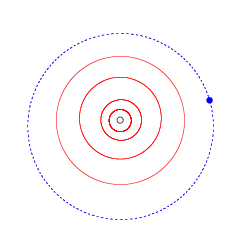
It has received the number 15760 and remains unnamed; it is normally referred to simply as "QB1", even though this is technically ambiguous without the year of discovery.
Sila-Nunam is very red in visible light and has a flat featureless spectrum in the near-infrared. There are no water ice absorption bands in its near-infrared spectrum, which resembles that of Ixion. Each has apparently been resurfaced with ejecta from impacts on the other.
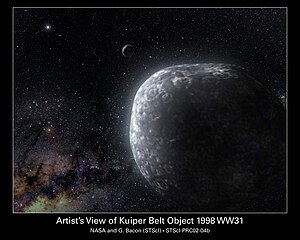 A double Kuiper belt object. It forms a binary system with another object with the provisional designation S/2000 (1998 WW31) 1: one of the most symmetrical binaries known in the Solar System.
A double Kuiper belt object. It forms a binary system with another object with the provisional designation S/2000 (1998 WW31) 1: one of the most symmetrical binaries known in the Solar System.
The two bodies are very close in size, with a diameter ratio of 1.2 and a mass ratio of 1.74, assuming similar surfaces and densities. Their combined mass is 1/6000th that of the Pluto-Charon system.
| 2010 KZ39 |
|---|
Its unusual orbit suggests that 2008 KV42 may have been perturbed inwards from its source, most likely in the inner Oort cloud, by an unknown gravitational disturbance. Its discovery may reveal the source regions for Halley-type comets which also have an retrograde orbit, but their origin remains unknown. 2008 KV42 itself is believed to be in an intermediate stage towards becoming a comet.
| Chaos |
|---|
| Makemake |
|---|
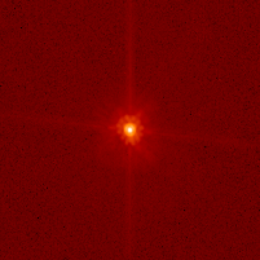 A dwarf planet and perhaps the largest Kuiper belt object (KBO) in the classical population, with a diameter that is about 2/3 the size of Pluto. Makemake has no known satellites, which makes it unique among the largest KBOs. Its extremely low average temperature, about 30 K means its surface is covered with methane, ethane, and possibly nitrogen ices.
A dwarf planet and perhaps the largest Kuiper belt object (KBO) in the classical population, with a diameter that is about 2/3 the size of Pluto. Makemake has no known satellites, which makes it unique among the largest KBOs. Its extremely low average temperature, about 30 K means its surface is covered with methane, ethane, and possibly nitrogen ices.
Makemake's orbit lies far enough from Neptune to remain stable over the age of the Solar System. Makemake, however, is a member of the "dynamically hot" class of classical KBOs, meaning that it has a high inclination compared to others in its population. Makemake is, probably coincidentally, near the 11:6 resonance with Neptune.
The surface of Makemake resembles that of Pluto. Like Pluto, Makemake appears red in the visible spectrum, and significantly redder than the surface of Eris. Spectral analysis of Makemake's surface revealed that methane must be present in the form of large grains at least one centimetre in size. In addition, large amounts of ethane and tholins may be present as well. The tholins are probably responsible for the red color of the visible spectrum. Although evidence exists for the presence of nitrogen ice on its surface, at least mixed with other ices, there is nowhere near the same level of nitrogen as on Pluto and Triton. The relative lack of nitrogen ice suggests that its supply of nitrogen has somehow been depleted over the age of the Solar System.
The surface of Makemake is not homogeneous. Although the majority of it is covered by nitrogen and methane ices, there are small patches of dark terrain that make up 3-7% of the surface.
Makemake presently lacks a substantial atmosphere. The presence of methane and possibly nitrogen suggests that Makemake could have a transient atmosphere similar to that of Pluto near its perihelion.
| Varda |
|---|
| 2010 RF43 |
|---|
| 2002 AW197 |
|---|
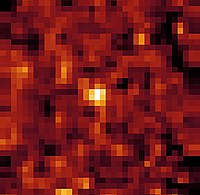 A classical Kuiper belt object (cubewano). A probable dwarf planet.
A classical Kuiper belt object (cubewano). A probable dwarf planet.
Light-curve-amplitude analysis shows only small deviations, which suggests that it is a spheroid with small albedo spots. Analysis of spectra reveals a strong red slope and no presence of water ice, suggesting organic material.
| 2007 JJ43 |
|---|
| 2003 QX113 |
|---|
| 2001 UR163 |
|---|
It has the reddest color index of any object in the Solar System. In the visible spectrum, 2001 UR163 would appear orange-brown, depending on its albedo.
| "Kuiper gap" or "Kuiper cliff" |
|---|
 The 1:2 resonance with Neptune appears to be an edge beyond which few objects are known. It is not clear whether it is actually the outer edge of the classical belt, or just the beginning of a broad gap. Objects have been detected at the 2:5 resonance at roughly 55 AU, well outside the classical belt; however, predictions of a large number of bodies in classical orbits between these resonances have not been verified through observation.
The 1:2 resonance with Neptune appears to be an edge beyond which few objects are known. It is not clear whether it is actually the outer edge of the classical belt, or just the beginning of a broad gap. Objects have been detected at the 2:5 resonance at roughly 55 AU, well outside the classical belt; however, predictions of a large number of bodies in classical orbits between these resonances have not been verified through observation.
Based on estimations of the primordial mass required to form Uranus and Neptune, as well as bodies as large as Pluto, earlier models of the Kuiper belt had suggested that the number of large objects would increase by a factor of two beyond 50 AU, so this sudden drastic falloff, known as the "Kuiper cliff", was completely unexpected, and its cause, to date, is unknown. Possible explanations include that material at that distance was too scarce or too scattered to accrete into large objects, or that subsequent processes removed or destroyed those that did. The gravitational attraction of an unseen large planetary object, perhaps the size of Earth or Mars, might be responsible.
| Scattered disc |
|---|
 The scattered disc (or scattered disk) is a distant region of the Solar System that is sparsely populated by icy minor planets, a subset of the broader family of TNOs. The scattered-disc objects (SDOs) have orbital eccentricities ranging as high as 0.8, inclinations as high as 40 degrees, and perihelia greater than 30 AU. These extreme orbits are believed to be the result of gravitational "scattering" by the gas giants, and the objects continue to be subject to perturbation by the planet Neptune.
The scattered disc (or scattered disk) is a distant region of the Solar System that is sparsely populated by icy minor planets, a subset of the broader family of TNOs. The scattered-disc objects (SDOs) have orbital eccentricities ranging as high as 0.8, inclinations as high as 40 degrees, and perihelia greater than 30 AU. These extreme orbits are believed to be the result of gravitational "scattering" by the gas giants, and the objects continue to be subject to perturbation by the planet Neptune.
Although the closest scattered-disc objects approach the Sun at about 30-35 AU, their orbits can extend well beyond 100 AU. This makes scattered objects among the most distant and coldest objects in the Solar System. The innermost portion of the scattered disc overlaps with a torus-shaped region of orbiting objects traditionally called the Kuiper belt, but its outer limits reach much farther away from the Sun and farther above and below the ecliptic than the Kuiper belt proper.
Because of its unstable nature, astronomers now consider the scattered disc to be the place of origin for most periodic comets in the Solar System, with the centaurs, a population of icy bodies between Jupiter and Neptune, being the intermediate stage in an object's migration from the disc to the inner Solar System. Eventually, perturbations from the giant planets send such objects towards the Sun, transforming them into periodic comets. Many Oort cloud objects are also believed to have originated in the scattered disc.
| 2002 TC302 |
|---|
| 2004 XR190 "Buffy" |
|---|
| 2007 OR10 |
|---|
 A very large planetoid located in the scattered disc. It is the largest known body in the Solar System without a name. It is approximately the size of Haumea, and appears to be a dwarf planet. It is in a 3:10 resonance with Neptune.
A very large planetoid located in the scattered disc. It is the largest known body in the Solar System without a name. It is approximately the size of Haumea, and appears to be a dwarf planet. It is in a 3:10 resonance with Neptune.
The spectrum of 2007 OR10 shows signatures for both water ice and methane, which makes it similar in composition to Quaoar. The presence of red methane frost on the surfaces of both 2007 OR10 and Quaoar implies the existence of a tenuous methane atmosphere on both objects, slowly evaporating into space. Although 2007 OR10 comes closer to the Sun than Quaoar, and is thus warm enough that a methane atmosphere should evaporate, its larger mass makes retention of an atmosphere just possible.
The presence of water ice on the surface of 2007 OR10 implies a brief period of cryovolcanism in its distant past.
| 2006 QH181 |
|---|
| Eris |
|---|
 Eris is the most massive known dwarf planet in the Solar System and the ninth most massive body known to orbit the Sun directly. It is 27% more massive than Pluto, or about 0.27% of the Earth's mass.
Eris is the most massive known dwarf planet in the Solar System and the ninth most massive body known to orbit the Sun directly. It is 27% more massive than Pluto, or about 0.27% of the Earth's mass.
Infrared light from the object revealed the presence of methane ice, indicating that the surface may be similar to that of Pluto, which at the time was the only TNO known to have surface methane, and of Neptune's moon Triton, which also has methane on its surface. Due to Eris's distant eccentric orbit, Eridian surface temperature is estimated to vary between about 30 and 56 kelvin
Unlike the somewhat reddish Pluto and Triton, however, Eris appears almost grey. It is far enough away from the Sun that methane can condense onto its surface even where the albedo is low. The condensation of methane uniformly over the surface reduces any albedo contrasts and would cover up any deposits of red tholins. Even though Eris can be up to three times further from the Sun than Pluto, it approaches close enough that some of the ices on the surface might warm enough to sublime.
As methane is highly volatile, its presence shows either that Eris has always resided in the distant reaches of the Solar System where it is cold enough for methane ice to persist, or that the celestial body has an internal source of methane to replenish gas that escapes from its atmosphere. This contrasts with observations of another discovered TNO, Haumea, which reveal the presence of water ice but not methane.
| 2010 EK139 |
|---|
| 2007 UK126 |
|---|
 A probable dwarf planet. Its orbital eccentricity suggests that it was gravitationally scattered onto its eccentric orbit.
A probable dwarf planet. Its orbital eccentricity suggests that it was gravitationally scattered onto its eccentric orbit.
| 2010 RE64 |
|---|
| 1996 TL66 |
|---|
| Termination shock |
|---|
 The termination shock is the point in the heliosphere where the solar wind slows down to subsonic speed (relative to the Sun) because of interactions with the local interstellar medium. This causes compression, heating, and a change in the magnetic field. In the Solar System the termination shock is believed to be 75 to 90 AU from the Sun.
The termination shock is the point in the heliosphere where the solar wind slows down to subsonic speed (relative to the Sun) because of interactions with the local interstellar medium. This causes compression, heating, and a change in the magnetic field. In the Solar System the termination shock is believed to be 75 to 90 AU from the Sun.
The shock arises because solar wind particles are emitted from the Sun at about 400 km/s, while the speed of sound (in the interstellar medium) is about 100 km/s (the exact speed depends on the density, which fluctuates considerably). The interstellar medium, although very low in density, nonetheless has a constant pressure associated with it; the pressure from the solar wind decreases with the square of the distance from the Sun. As one moves far enough away from the Sun, the pressure from the interstellar medium becomes sufficient to slow the solar wind down to below its speed of sound; this causes a shock wave.
The heliosphere may be irregularly shaped, bulging outwards in the Sun's northern hemisphere and pushed inward in the south.
| Heliosheath |
|---|
The Voyager 1 and Voyager 2 spacecraft are currently studying the heliosheath. In late 2010, Voyager 1 reached a region of the heliosheath where the solar wind's velocity had dropped to zero.[ In 2011, astronomers announced that the Voyagers had determined that the heliosheath is not smooth, but is filled with 100 million-mile-wide bubbles created by the impact of the solar wind and the interstellar medium. The probably sausage-shaped bubbles are formed by magnetic reconnection between oppositely oriented sectors of the solar magnetic field as the solar wind slows down. They probably represent self-contained structures that have detached from the interplanetary magnetic field.
| Ceto |
|---|
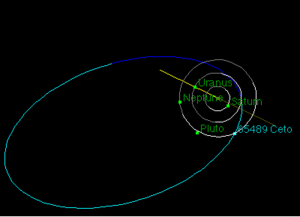 Ceto is a close binary TNO in which the components are of similar size. It has been suggested that tidal forces, together with other potential heat sources might have raised the temperature sufficiently to crystallise amorphous ice and reduce the void space inside the object. The same tidal forces could be responsible for the quasi-circular orbits of the components of Ceto.
Ceto is a close binary TNO in which the components are of similar size. It has been suggested that tidal forces, together with other potential heat sources might have raised the temperature sufficiently to crystallise amorphous ice and reduce the void space inside the object. The same tidal forces could be responsible for the quasi-circular orbits of the components of Ceto.
| Heliopause |
|---|
The crossing of the heliopause should be signaled by a sharp drop in the temperature of charged particles, a change in the direction of the magnetic field, and an increase in the amount of galactic cosmic rays.
In the fall of 2013, NASA announced that Voyager 1 had crossed the heliopause as of August 25, 2012. This was at a distance of 121 AU from the Sun. Contrary to predictions, data from Voyager 1 indicates the magnetic field of the galaxy is aligned with the solar magnetic field.
The shape of this newly found tail by NASA's Interstellar Boundary Explorer (IBEX) is that of a four-leaf clover. Due to the particles in the tail, they do not shine, therefore it cannot be seen with conventional instruments. IBEX has made the first observations by using a technique called "energetic neutral atom energy" which is the process of measuring the neutral particles created by collisions at the solar system's boundaries.
The tail has shown to obtain fast and slow particles; the slow particles are on the side and the fast particles are encompassed in the center. The shape of the tail can be linked to the sun sending out fast solar winds near its poles and slow solar wind near its equator more recently. The clover-shaped tail moves further away from the sun, which makes the charged particles begin to morph into a new orientation.
| Bowshock |
|---|
This phenomenon has been observed outside our solar system, around stars other than the Sun. The red giant star Mira in the constellation Cetus has been shown to have both a debris tail of ejecta from the star and a distinct shock in the direction of its movement through space (at over 130 km/s).
| 90377 Sedna |
|---|
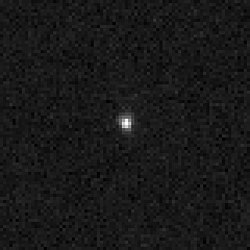 Its surface composition is similar to that of some other trans-Neptunian objects, being largely a mixture of water, methane and nitrogen ices with tholins. Its surface is one of the reddest in the Solar System. Sedna's exceptionally long and elongated orbit has led to much speculation as to its origin. It may be the first known member of the inner Oort cloud. Others speculate that it might have been tugged into its current orbit by a passing star, perhaps one within the Sun's birth cluster, or even that it was captured from another star system. Another hypothesis suggests that its orbit may be evidence for a large planet beyond the orbit of Neptune.
Its surface composition is similar to that of some other trans-Neptunian objects, being largely a mixture of water, methane and nitrogen ices with tholins. Its surface is one of the reddest in the Solar System. Sedna's exceptionally long and elongated orbit has led to much speculation as to its origin. It may be the first known member of the inner Oort cloud. Others speculate that it might have been tugged into its current orbit by a passing star, perhaps one within the Sun's birth cluster, or even that it was captured from another star system. Another hypothesis suggests that its orbit may be evidence for a large planet beyond the orbit of Neptune.
Measurements suggest a rotational period of 10 hours. Sedna's dark red colour may be caused by a surface coating of hydrocarbon sludge, or tholin, formed from simpler organic compounds after long exposure to ultraviolet radiation. Its surface is homogeneous in colour and spectrum; this may be because Sedna, unlike objects nearer the Sun, is rarely impacted by other bodies, which would expose bright patches of fresh icy material like that on 8405 Asbolus. Models of internal heating via radioactive decay suggest that Sedna might be capable of supporting a subsurface ocean of liquid water.
| Oort Cloud |
|---|
 The Oort cloud (sometimes called the Opik-Oort Cloud), is a hypothesized spherical cloud of comets which may lie roughly 50,000 AU, or nearly a light-year, from the Sun. This places the cloud at nearly a quarter of the distance to Proxima Centauri, the nearest star to the Sun. The Kuiper belt and the scattered disc, the other two reservoirs of trans-Neptunian objects, are less than one thousandth of the Oort cloud's distance. The outer limit of the Oort cloud defines the cosmographical boundary of the Solar System and the region of the Sun's gravitational dominance.
The Oort cloud (sometimes called the Opik-Oort Cloud), is a hypothesized spherical cloud of comets which may lie roughly 50,000 AU, or nearly a light-year, from the Sun. This places the cloud at nearly a quarter of the distance to Proxima Centauri, the nearest star to the Sun. The Kuiper belt and the scattered disc, the other two reservoirs of trans-Neptunian objects, are less than one thousandth of the Oort cloud's distance. The outer limit of the Oort cloud defines the cosmographical boundary of the Solar System and the region of the Sun's gravitational dominance.
Astronomers believe that the matter composing the Oort cloud formed closer to the Sun and was scattered far out into space by the gravitational effects of the giant planets early in the Solar System's evolution. It is speculated that the Oort cloud is, at least partly, the product of an exchange of materials between the Sun and its sister stars as they formed and drifted apart. Objects in the Oort cloud are largely composed of ices, such as water, ammonia, and methane. However, the discovery of the object 1996 PW, an asteroid in an orbit more typical of a long-period comet, suggests that the cloud may also contain rocky objects.
Although no confirmed direct observations of the Oort cloud have been made, astronomers believe that it is the source of all long-period and Halley-type comets entering the inner Solar System and many of the centaurs and Jupiter-family comets as well. The outer Oort cloud is only loosely bound to the Solar System, and thus is easily affected by the gravitational pull both of passing stars and of the Milky Way Galaxy itself. These forces occasionally dislodge comets from their orbits within the cloud and send them towards the inner Solar System. Based on their orbits, most of the short-period comets may come from the scattered disc, but some may still have originated from the Oort cloud.
Models suggest that the scattered disc, which is the main source for periodic comets in the Solar System, might also be the primary source for Oort cloud objects. According to the models, about half of the objects scattered travel outward towards the Oort cloud, while a quarter are shifted inward to Jupiter's orbit, and a quarter are ejected on hyperbolic orbits. The scattered disc might still be supplying the Oort cloud with material. A third of the scattered disc's population is likely to end up in the Oort cloud after 2.5 billion years.
Gravitational interaction with nearby stars and galactic tides modified cometary orbits to make them more circular. This explains the nearly spherical shape of the outer Oort cloud. On the other hand, the Hills cloud, which is bound more strongly to the Sun, has yet to acquire a spherical shape. Recent studies have shown that the formation of the Oort cloud is broadly compatible with the hypothesis that the Solar System formed as part of an embedded cluster of 200-400 stars. These early stars likely played a role in the cloud's formation, since the number of close stellar passages within the cluster was much higher than today, leading to far more frequent perturbations.
It is thought that other stars are likely to possess Oort clouds of their own, and that the outer edges of two nearby stars' Oort clouds may sometimes overlap, causing the occasional intrusion of a comet into the inner solar system. The star with the greatest possibility of perturbing the Oort cloud in the next 10 million years is Gliese 710.
REFERENCES
|
|
|
| TOP | LEGAL | MAIN INDEX |